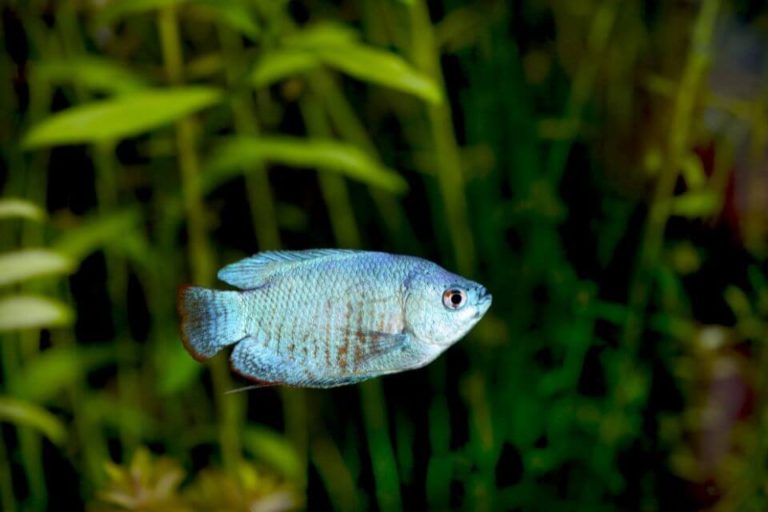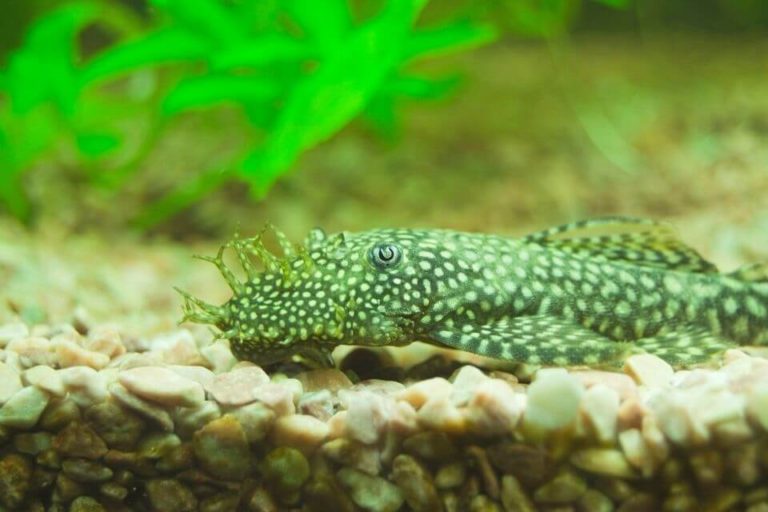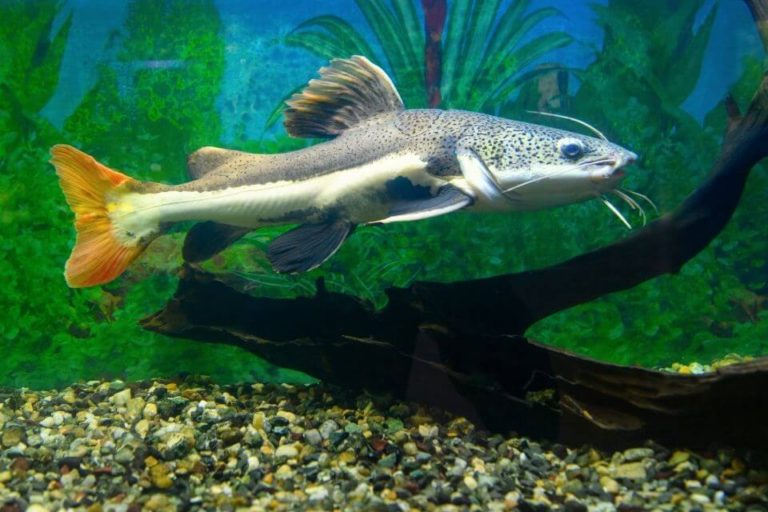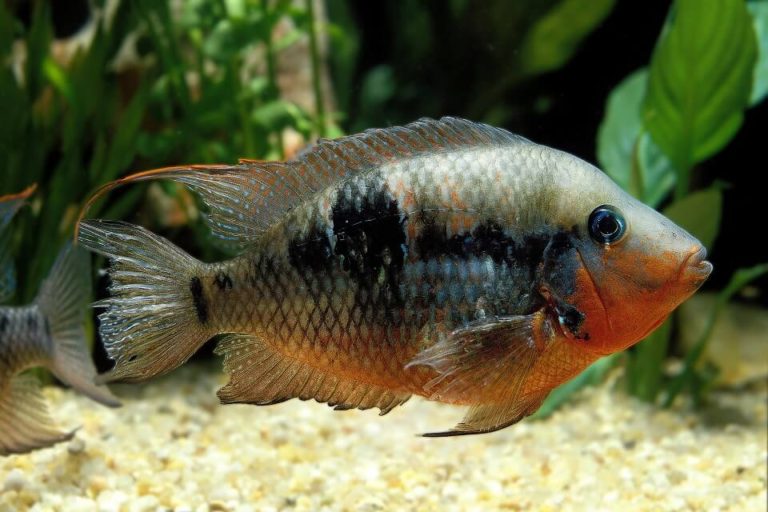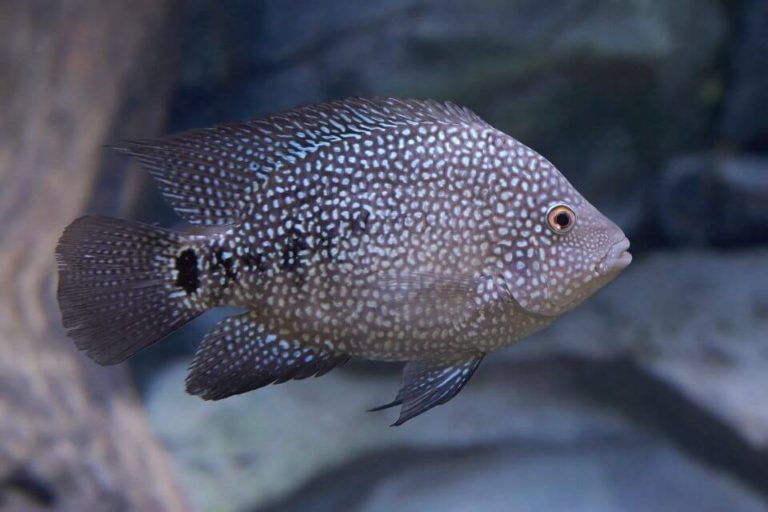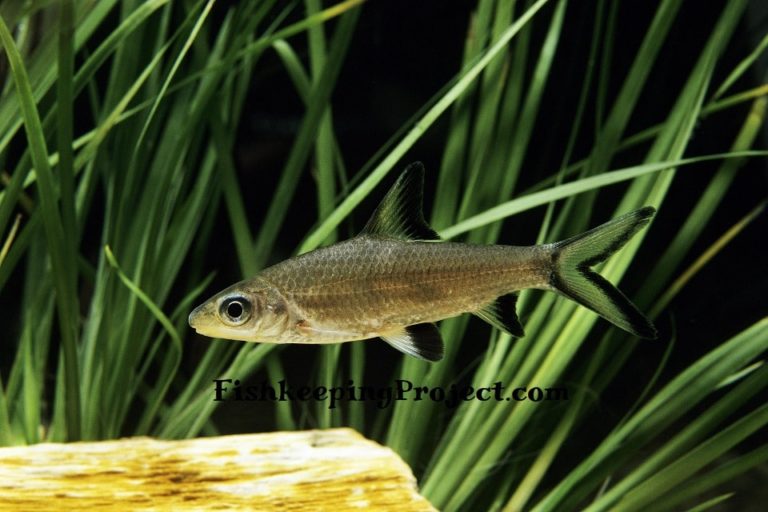Royal Pleco Care: Lifespan, Size, Food, Tank Mates, Tank Size

Royal Pleco is one of the largest fish species that you can keep in your freshwater fish tank. There are over 150 pleco species discovered so far in different parts of the world.
Many do not thrive in captivity because of different biological needs from those found in the wild. Despite their large size, Royal Plecos make great aquarium residents when housed with other non-aggressive tankmates.
They are also known as Royal Catfish, and they’re a prevalent freshwater aquarium species due to their gorgeous appearance and non-aggressive demeanor.
The Royal Pleco requires live plants, driftwood or bog-wood, and a large aquarium due to their adult size. They are nocturnal fish that will rest during the day under rocks or in caves.
This Royal Pleco care guide will share some knowledge on this fascinating pleco species with hobbyists who plans to keep Royal Pleco as a pet.
| Quick Facts: | |
|---|---|
| Common Names | Royal Pleco, Royal Panaque |
| Origin | River basins of Amazon and Orinoco Reivers, South America. |
| Family | Loricariidae |
| Scientific Name | Panaque nigrolineatus |
| Care Level | Medium |
| Temperament | Peaceful |
| Social | Community friendly |
| Diet | Omnivores |
| Size (average) | Up to 17 inches |
| Lifespan | Up to 10 years |
| Breeding | Egg layer |
| Minimum Tank Size | 120 gallons |
| Tank Setup | Freshwater, fine sand substrate, driftwood, flats rock surfaces for decorations. Include clay ports and caves for hiding places. Avoid bright lights. |
| Tank Temperature | 72 - 79 °F (22 – 26 °C) |
| Water Hardness | 5 - 15 dGH |
| Water pH Level | 6.5 - 7.5 |
Species Overview
Royal Pleco is a large member of the Loricariidae family of armored catfish. It has an elongated body that can grow to a considerable size, especially in older specimens. It’s also covered in bony plates.
It has an underbite that is not easily noticed when viewed from above or from a side view. These Pleco species s are usually jet black with some white ‘trim’ on their fins and tail.
Royal Plecos usually grow up to around 17 inches (43 cm), so you will need a large tank if you intend to keep them. They’re not the only fish that can get this big, but it’s still an important consideration when buying one.
These fish species are not necessarily aggressive fish despite having somewhat of a ferocious look to them. However, some may become territorial or aggressive towards small fish, so you should choose tankmates carefully.
Royal Pleco Size
Royal Pleco size can grow to a big and are usually quite heavy too. A mature Royal Pleco can grow up to 17 inches (43 cm) or so. When buying one, keep in mind that you will need a very large tank if you intend to support them.
They’re not the only fish that grow this big. For example, goldfish and Oscars get bigger, but you should consider them before buying any aquatic pet.
Royal Pleco Lifespan
Royal plecos have a long lifespan of 10 years or more. This is because they are pretty inactive and usually just lay around all day, which means their body doesn’t wear out as quickly as other more active fish would.
However, some may live longer than this, particularly those from the original area where they come from (Brazil).
Appearance and Colors
Different types of royals may have different colors, particularly markings on their fins. The Royal Pleco has an elongated body covered with bony plates, usually black or tan-colored depending on its exact subspecies.
They have a prominent underbite that is often not very apparent unless viewed from above or side. As they grow older, they will also become darker in color, eventually appearing jet-black.
They also have two fleshy pectoral ‘fins’ that stick out of their body on each side; these are shorter than the dorsal fin but still quite long for a pleco. The dorsal fin usually reaches almost to the tail.

Behavior & Temperament
Royal plecos are usually relatively peaceful fish but may become territorial towards small fish, especially those of the same species.
You can solve this by keeping them with larger ones who will make the smaller fish flee before getting hurt or purchasing a big tank enough for everyone to have their own space.
Royal plecos are usually relatively peaceful towards other fish, although various subspecies may vary depending on how closely they’re related. You should research each type if you want to keep several together.
Smaller fish are generally safe, though, as long as there are no similar-looking types around for them to try and mimic or steal food from. In this case, it might not be a good idea to keep them together.
Royal plecos are also algae-eating fish, so they should never be kept with other plecos. Also, not all types of Pleco are bottom feeders, so it would probably be best if you find out which type yours is before purchasing tankmates.
Royal Pleco Care
They from the tropical waters of South America and is a bottom-dwelling fish. Also can grow up to 17 inches in length. You should provide them with at least 120 gallons of water with plenty of rocks and driftwood for them to graze on.
The substrate should consist of fine gravel or sand as they will sometimes graze along the surface for algae. Lighting need not be intense unless you are keeping live plants in your tank.
Make sure that there are no fast-growing stem plants that could become a nuisance under their constant grazing. Royal Plecos do best when kept alone, although very large groups may sometimes coexist peacefully if introduced at a young age.
But this is not a recommended method as they may still attack each other.
– Royal Pleco Tank Size
The Royal Pleco requires a tank that contains at least 120 gallons of water per fish. Because of Their larger size, you should provide them with plenty of driftwood and rocks, as well as some flat surfaces for grazing on algae.
Lighting need not be powerful unless your aquarium contains live plants, but if this is the case, make sure that there are no fast-growing stem plants that could become a nuisance under their constant grazing.
Royal Plecos do best when kept alone unless introduced at a young age. Very large groups may sometimes coexist peacefully if introduced at a young age, although this is not a recommended method as they may still attack each other.
– Royal Pleco Tanks Setup
When setting up the tank, you should ensure that it is a stable environment for your fish. For substrate, use either sand or fine gravel.
If using live plants, be sure to remove any fast-growing varieties from the tank before they become a nuisance under their constant grazing. Add driftwood and rocks to provide hiding places and add extra decoration.
Make sure not to purchase ones that have been treated with chemicals such as pesticides or fertilizers. You may also want to include some flat surfaces in your aquarium so that your Pleco has somewhere to graze on algae.
Lighting need not be intense because these types of Pleco come from dark waters. If you keep live plant species in your tank, use some illumination.
– Water Conditions and Parameters
As the Royal Pleco comes from tropical waters, you must keep their aquarium within these parameters.
- Water temperature: 72°F – 79°F (22-26 degrees Celsius)
- Ranges of pH: 6.5 – 7.5
- Water hardness: 5 – 15 dGH
– Suitable Aquarium Plants
If you plan to keep live plants in your Pleco tank, select fast-growing stem plants rather than slow-growing ones, which will take more time for them to graze on.
It could lead to problems between fish who cannot share the same space comfortably. Any substrate used should consist of gravel and sand as they will sometimes graze along the surface for algae.
– Possible Diseases and Prevention
The Royal Pleco is not particularly vulnerable to any diseases or parasites. Still, if you are concerned about introducing one into your aquarium, you should quarantine it for around six weeks before adding the rest of your fish.
This will allow it to get used to its new surroundings and reduce stress levels.
Just like in other species of fish, there are a few things you can do to prevent your Royal Pleco from contracting any diseases or infections, including the following:
-
Maintain good water conditions
You should maintain the water conditions and parameters of your aquarium at all times. The water should have an optimum temperature.
If the water becomes too cold for them, they may become sluggish, stop eating and avoid interaction with other fish. If it gets too hot, their behavior will become anxious and erratic, again resulting in a loss of appetite and damage to their gills.
-
Maintain a suitable diet
By keeping to the proper feeding schedule, your fish will remain healthy and avoid any diseases that can develop from not getting the required nutrients in their diet.
-
Keep debris and uneaten food cleaned up at all times
If left lying around, it can rot, releasing harmful toxins into your aquarium or attracting pests such as algae-eating snails, which may prey on your fish.
-
Make sure they are getting enough exercise
Ensure they have enough space to swim about so they do not become stressed. Overcrowding an aquarium can not only result in stress but may also contribute to the development of diseases.
-
Avoid the existence of toxic agents, pesticides, chemicals and medications, and parasites
Read up on all recommended treatments for your aquarium before administering them. If uncertain about any products, then do not use them. This will reduce the risk of poisoning your fish.
Royal Pleco Diet and Feeding
The Royal Plecos are omnivores so they will eat both meat and plant matter. Although many different species of plecos vary in their dietary needs, most of them similar to this species will primarily feed on algae and biofilm on solid surfaces.
To provide them with a varied diet, you should include some vegetable matter in their diet; although it’s not essential for their survival, it will make them much healthier, which means they can grow larger!
Gender Differences
Both male and female Royal Plecos grow to around 17 inches. Males tend to be smaller than females of the same age range, but this is not always the case. Suppose you notice any significant visible differences between the two.
In that case, there’s no harm in checking with an expert fish keeper or seller if you’re unsure. It is almost undoubtedly male if your Royal Pleco has red eyes instead of black and pink or red anal or facial fins.
If you note their body shape is slim at the bottom and chunky instead of wide you can spot it as a male fish. In the same way, you can spot female fish if their body tapers off towards the tail.
In males, they’ll tend to have a pretty even thickness from top to bottom.
Royal Pleco Breeding
Royal Plecos can spawn in an aquarium environment where water parameters have been stable, and good conditions are generally provided.
As with all spawning fish, males will usually attract females into a suitable spawning site which he then guards until she lays her eggs and they’ve fertilized.
Joining spawning sites together and providing a suitable cave or plant matter may be all it takes to induce spawning. Ensure you keep an eye on the site every day and remove parents soon as they’re laid.
This is to prevent the eggs from accidentally being eaten by the parents and keep them in their tank where they can hatch out safely.
Royal Pleco Tank Mates
Avoid keeping them with small peaceful community fish such as Tetras, guppies, and livebearers. Always keep them in groups of at least 2 to avoid any fish becoming a target for the others.
You can house them with medium-sized species such as Cichlid species and Catfish if you provide enough room for everyone, but try and make sure the species you choose will generally ignore each other.
FAQs
Can You Put 2 Plecos in The Same Tank?
They are territorial fish and might be okay housed together as long as they both have enough room to establish their territory, but more often than not, they will fight if kept in the same aquarium.
If you want two, then ensure there are plenty of hiding places for both of them.
Are Royal Plecos Nocturnal?
Royal Plecos are Nocturnal fish, which means they are active during the night and sleep during the day. However, you may still see your Royal Plecos out in daylight hours.
They might even spend some time out of their caves hunting at this time. But for most of the day, they’ll be tucked inside somewhere sleeping.
Do Royal Plecos Eat Algae?
They certainly do. The Royal Pleco is a shoaling species that will eat almost anything provided it can fit into their mouths! Place some algae wafers or flakes at different positions on the glass, so your plecos have a choice as to which one they want.
Are Royal Plecos Aggressive?
Royal Plecos can be quite aggressive, mainly if housed with a tank mate that is smaller than them. They might see it as a threat and view them as food. If this happens, you’re going to end up with the Pleco eating any little fish in there.
Are Royal Plecos Rare?
Royal Plecos are relatively rare in the wild now due to people taking them to aquariums. Sharks have also contributed to their decline. However, they are being bred in large numbers today.
They’re still relatively expensive, though, because of their rarity and need for special care.
How Big Do Royal Plecos Get?
They can reach around 43 cm or 17″ in length, which is more significant than other pleco species. They’re also very bulky. You need to give them the ‘space’ they deserve when choosing an aquarium for them or getting one custom built.
This is especially true if you keep more than just 1 of these fish because having lots of space means less chance of aggression between them.
How Long Do Royal Plecos Live?
It’s not uncommon for these fish to live over 10 years with proper care, so keeping them is a long-term commitment. Females tend to live longer than males. It might be easier and cheaper to hold a young female than an older male.
Where Is Royal Pleco for Sale?
You can find Royal Plecos for sale at most pet stores, mainly selling L-number catfish species. Some specialist aquarium shops and online stores sell them, too, including Amazon and eBay. It’s worth shopping around for the best deals.
How Much Is a Royal Pleco Worth?
You can pay anything from $20 to $50 for a Royal Pleco depending on who you buy it from, how old it is, and whether or not there are any offers available. The price sometimes includes the cost of delivery too.
If they charge you extra for this, ensure to check their terms or returns policy if you change your mind later.
Final Thoughts
There’s no doubt that Royal Plecos are exciting and beautiful Armored Catfish species. As long as it comes from a reputable source, you should have no problems giving them the care they need.
They also make good pets, so if you don’t mind giving something new life, then consider keeping them. Just bear in mind their adult size and needs before making a final decision because selling them once they’ve grown too large is not easy.
There aren’t many buyers out there willing to purchase an adult Royal Pleco. Many people buy them when they’re small, and they grow into large fish very quickly.
I hope that this article answers all your ‘questions’ about Royal Plecos Care!


